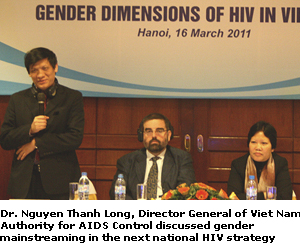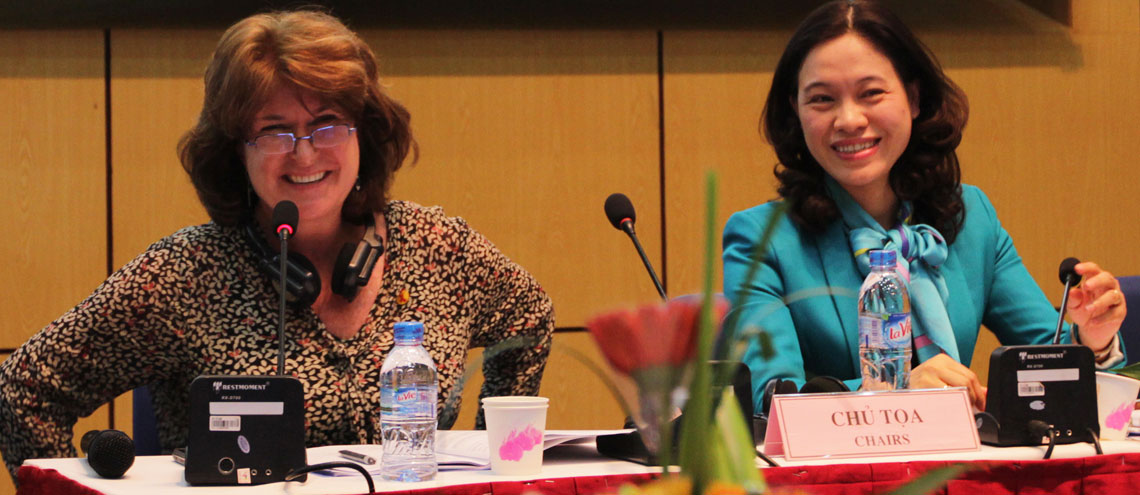Different Strategies Needed to Reduce HIV Risk to Women and Men
 Efforts to prevent HIV infections and provide services to people living with the virus can be improved through stronger understanding of the different risks and needs of women and men within key populations, such as women who inject drugs, male sex workers and women whose husbands engage in high-risk behaviours, according to UN experts.
Efforts to prevent HIV infections and provide services to people living with the virus can be improved through stronger understanding of the different risks and needs of women and men within key populations, such as women who inject drugs, male sex workers and women whose husbands engage in high-risk behaviours, according to UN experts.
Nazneen Damji, Gender Equality and HIV/AIDS Programme Manager with UN Women in New York, and Jane Wilson, Gender Advisor with the UNAIDS Regional Support Team in Bangkok, visited Ha Noi on March 14-17 to raise awareness on HIV and gender among Government officials, civil society and people living with HIV in Viet Nam.
The experts shared their technical expertise with local partners supporting development of Viet Nam’s 2011-2020 National Strategy on HIV/AIDS Prevention and Control.
There is growing recognition of the need to engender the response to Asia’s largely concentrated HIV epidemics. A United Nations-supported analysis of the current strategy for Viet Nam’s HIV response identified areas that could better respond to the specific needs of women and men within populations most affected by the epidemic. It also highlighted the commitment of the Government of Viet Nam and major stakeholders to develop a comprehensive response to HIV, as well as the prioritization of gender equality within the country’s socio-economic development efforts.
“We need to comprehensively mainstream gender issues in all the three pillars of the next strategy including prevention, treatment and care, and impact mitigation,” said Dr. Nguyen Thanh Long, Director General of the Viet Nam Authority for AIDS Control (VAAC).
“Gender issues therefore need to be specifically addressed in the baseline analysis for the strategy and gender sensitive indicators need to be developed,” he added.
Increasingly, HIV is affecting women in Viet Nam. According to VAAC, women accounted for as much as 30% of the total registered HIV infections in Viet Nam in 2010, while prior to 2005 this rate was less than 15%. The epidemic in Viet Nam is still concentrated among mostly male injecting drug users, but this change in the sex ratio of newly reported HIV cases may reflect a growing risk of HIV transmission from men with high risk behaviours to their wives or regular sexual partners.
A lack of analysis on how economic reform and social changes have different impacts on men and women and make them vulnerable to HIV; a lack of sex and age disaggregated indicators to inform better targeted interventions; and a lack of capacity to understand gender dimensions of the HIV epidemic in Viet Nam are hampering efforts to realize universal access to HIV prevention, treatment, care and support services in the country.
“I have seen good signals of an engendered HIV strategy for Viet Nam,” said Suzette Mitchell, UN Women Country Representative in Viet Nam who co-chaired all discussion sessions together with UNAIDS Viet Nam Country Director Eamonn Murphy and leaders of the national response. “Viet Nam has strong political commitment to address gender issues and the civil society was very engaged and provided many good ideas for gender mainstreaming in the strategy.”
“This is what the UN needs to do more on the ground, providing our support jointly for the better of the people of Viet Nam,” Ms. Mitchell said.




